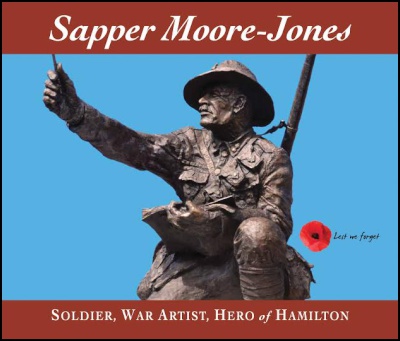Book Tells the Story of New Zealand Anzac War Artist
Book Tells the Touching Story of New Zealand Anzac War Artist Who Was Nearly Forgotten.

A new book on ANZAC war artist Horace Moore-Jones, is made more extraordinary by the story of how it’s taken the First World War centenary for him to receive due public recognition - almost 100 years late.
In a society that proudly bandies about the theme ‘Lest we forget’, the book tells the story of how TOTI, a small group from Hamilton took up the call to ensure that ‘Sapper Moore-Jones’ is not forgotten.
TOTI chair Bill McArthur says the book is being published in response to renewed public interest generated by their prominent Hamilton statue of Moore-Jones - unveiled in Hamilton’s CBD to mark Anzac Day and the First World War.
“People now want to know more, who is this important artist and hero, and why it’s taken so long” says McArthur. “So we are publishing a book about it all, a photographic and print archive.”
Moore-Jones painted the iconic watercolour ‘The man with the donkey’, considered among the most important pieces of Australasian war art, with an original selling last year for $500,000 at auction in Auckland despite calls to have it picked up for the nation.
Moore-Jones died a hero in 1922, rescuing people from the Hamilton Hotel fire.
Sapper Moore-Jones was among the first Anzac soldiers in the disastrous April 1915 Gallipoli Landing. A highly valued war artist, he acted as the eye of the army, sketching enemy positions, even aloft in a ship’s tethered balloon. Wounded and discharged, he recuperated in England, holding several successful exhibitions, including one at Buckingham palace, and regarded as important for the entire empire.
On return to New Zealand, his desire to fundraise for returned servicemen saw Moore-Jones taking his paintings on a two-year lecture tour around the country. Very quickly, he became a celebrity as thousands flocked to eagerly hear the ‘Anzac warrior’ truthfully portray the disastrous Gallipoli campaign and the Turks.
There was public controversy over the New Zealand Government’s refusal to buy the Moore-Jones Gallipoli collection, and ongoing calls for his honouring by the nation following his heroic 1922 death. There are several original versions of the Gallipoli donkey scene painted by the artist.
ENDS


 NZEI: Ministry Of Education Cuts Will Disproportionately Affect Pasifika
NZEI: Ministry Of Education Cuts Will Disproportionately Affect Pasifika Day One Hapai te Haeata: Call To Action For Young Filmmakers Against The Backdrop Of Funding Cuts
Day One Hapai te Haeata: Call To Action For Young Filmmakers Against The Backdrop Of Funding Cuts Toyota New Zealand: Three Races For Top Three To Decide TR86 Title
Toyota New Zealand: Three Races For Top Three To Decide TR86 Title Wellington City Council: Wellington Is All Action Stations For The Faultline Ultra Festival
Wellington City Council: Wellington Is All Action Stations For The Faultline Ultra Festival Melanie Allison: Local Playwright Casts A Spell Over Hamilton
Melanie Allison: Local Playwright Casts A Spell Over Hamilton Te Kohao Health: New $12M Wellness & Diagnostic Centre Opens In Hamilton ‘Disrupting The Historic Continuum’ For Māori
Te Kohao Health: New $12M Wellness & Diagnostic Centre Opens In Hamilton ‘Disrupting The Historic Continuum’ For Māori